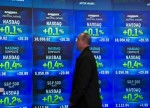
- All Instrument Types
- Indices
- Equities
- ETFs
- Funds
- Commodities
- Currencies
- Crypto
- Bonds
- Certificates
Please try another search

- Market volatility could continue on unclear Fed policy path
- Treasury yields surge, potentially confirming future rate
Friday's Nonfarm Payrolls release—which showed the US economy added 467,000 new jobs in January—shocked analysts who had been expecting a negative number for the first month of 2022 when Omicron cases surged. Moreover, payrolls revisions for November and December showed an additional 709,000 jobs added retroactively during the final two months of 2021. As well, Friday's data indicated wages had jumped by 5.7% YoY during January.
The unexpected, and for some, astounding employment data, suggests inflation remains hot. As such, investors will seek confirmation from this coming week's Consumer Price Index print, scheduled for Thursday. Another data set that could be relevant amid the fastest escalation in inflation in four decades is consumer sentiment; this coming Friday's University of Michigan consumer sentiment survey will be closely watched as well.
Still, rising inflation, even when balanced by better than expected economic data, has proven confusing for investors. After Fed Chair Jerome Powell's hawkish financial policy tilt early last month, indicating that rate hikes were upcoming, investors started selling off stocks, which resulted in the worst decline in years for equities during January.
Even with Fed officials busily backpedaling last week in an effort to calm markets, equities remained volatile. Adding to the potentially mercurial mood this coming week, earnings season continues with key companies such as drug makers Pfizer (NYSE:PFE) and Amgen (NASDAQ:AMGN) reporting as Omicron continues to proliferate. As well, consumer staple giants Coca-Cola (NYSE:KO), PepsiCo (NASDAQ:PEP) and Kellogg (NYSE:K) release results; all, or at least some, of these firms likely to benefit from the cyclical rotation that remains in play.
The S&P 500 climbed 0.52% on Friday, having gained 1.55% for the week.
The broad benchmark is likely forming a rising flag, bearish after the preceding sharp selloff. We also predict that the flag, once formed, will have created the right shoulder of an H&S top. However, that reversal pattern is complete only upon a downside breakout of its neckline.
Economically sensitive sectors were last week's leaders. Energy outperformed, jumping nearly 5% for the week, followed by +3.56% for Financials over the same timeframe; Consumer Discretionary shares tracked directly behind, up 3.54%.
The biggest weekly sector laggard was Communication Services, down 1.58%, after shares of Meta Platforms (NASDAQ:FB) plunged 26% on Thursday. The social media giant, which owns Facebook, Instagram and WhatsApp, disappointed on earnings, even as most SPX companies have so far met or beaten on expectations.
Moreover, Facebook's total user base fell for the first time since the social media platform was launched. Adding to investor displeasure, the Menlo Park, California-based tech giant warned that growth would slow in the coming quarter due to Apple (NASDAQ:AAPL) allowing its users to opt out of tracking on its devices, hampering Meta's ability to provide appropriate targeting to advertisers. It's estimated this could cost FB $10 billion a year.
The stock may find support at the 200 WMA. Even if the stock jumps, it could simply be forming the right side of an H&S top.
Meanwhile, Treasuries are signaling higher rates upcoming. The yield on the 10-year benchmark note surpassed 1.900% on Friday, for the first time since July 2019.
Yields broke out of the small symmetrical triangle we've been monitoring, after forming a much larger symmetrical triangle, suggesting higher yields ahead in the near term.
Last week, the dollar plunged.
However, it found support on Friday by the bottom of a rising channel.
Gold rose slightly but may be trading within a bearish pattern.
The yellow metal has been ranging higher inside what could prove to be a rising channel, following a sharp, three-day selloff. Falling gold would coincide with a rising dollar.
Bitcoin jumped on Thursday, to move back above $40K.
The cryptocurrency is testing the top of a rising channel, bearish after the preceding sharp downturn which was the downside breakout of an earlier bearish flag, itself the downside penetration of an H&S top. The implied target of the H&S suggests a much larger double top. That implied target could take the digital token to multi-year lows.
Oil extended its rise for a seventh week as it gained 2.2%, finishing out the week at $91.95.
The Week Ahead
All times listed are EST
Monday
2:00: Germany – Industrial Production: forecast to rise 0.4% from -0.2%.
Tuesday
8:30: US – Trade Balance: seen to slump to -83.00B from -80.20B previously.
Wednesday
10:30: US – Crude Oil Inventories: expected to show a build of 1.525M from the previous -1.046M drawdown.
Thursday
8:30: US – Core CPI: predicted to edge lower to 0.5% from 0.6% MoM.
8:30: US – Initial Jobless Claims: to print lower, at 228K after last week's 238K reading.
15:15: UK – BoE Gov Bailey Speaks
Friday
2:00: UK – GDP: to remain flat at 1.1% QoQ.
2:00: UK – Manufacturing Production: to fall to 0.2% from 1.1% MoM.
5:30: Russia – Interest Rate Decision: forecast to jump to 9.50% from 8.50%.
10:00: US – Fed Monetary Policy Report




